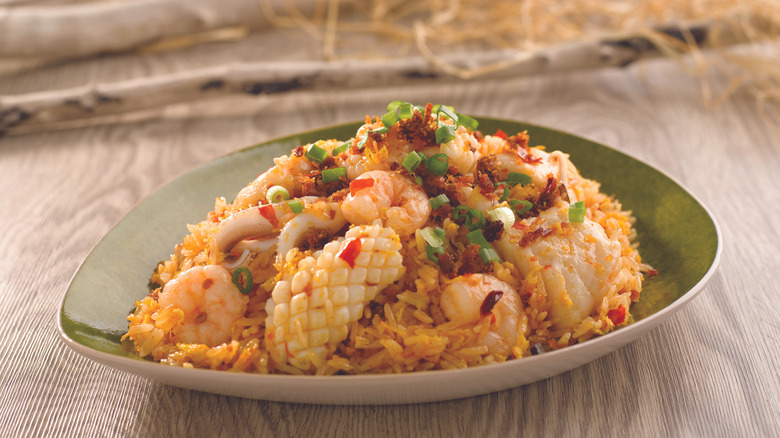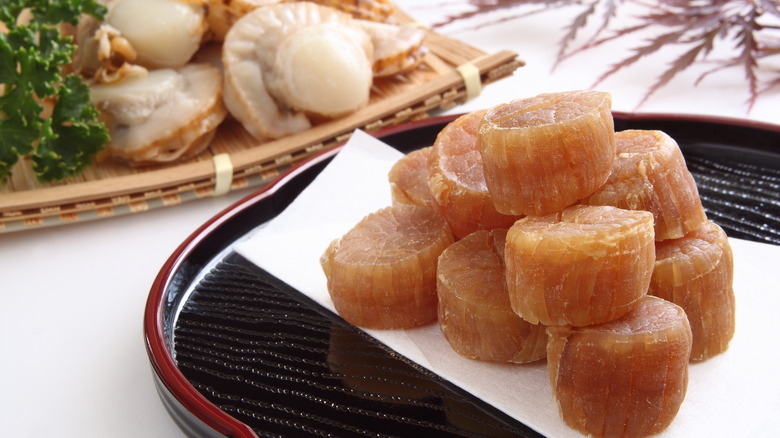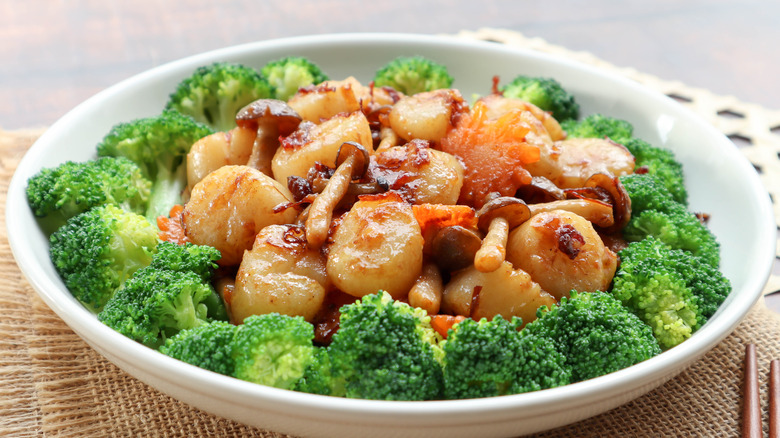XO Sauce Is A Masterpiece Of Flavor With Expensive Ingredients
Picture this, a condiment that embodies opulence, bursting with aroma and umami, thanks to a unique blend of spices and often expensive ingredients like dried scallops and hams like Jinhua and Italian. The sauce we're talking about can turn any humble dish into a luxurious feast.
Enter XO sauce, a culinary masterpiece of flavor that has captivated global cuisine since it was conceived in Hong Kong in the 1980s. Its name, XO, is acronymous for "extra-old," inspired by the high-end designation of French cognac Rémy Martin, which surged in popularity amongst Hong Kongers in the eighties and remains popular today. While it's unclear who first invented this sauce, many believe it was an ingenuous chef at the Peninsula Hotel in Hong Kong.
XO only pinched part of the name, not the ingredients, as the sauce contains no cognac and isn't aged or fermented. But, make no mistake, XO sauce is just as bougie as the drink it's named after, which is part of the reason it became a symbol of high-end Cantonese cooking, the other being its list of luxurious ingredients.
Why XO sauce is so expensive
It's the blend of extravagant ingredients that drives the price of a jar of this seafood jam upwards of $30. And while garlic, chilies, oils, and spices constitute the basic and cheap components for what the James Beard Foundation has nicknamed the "caviar" of the East, the ingredients contributing to this gourmet sauce's hefty price tag are premium dried seafood — mainly shrimp and conpoy (dried scallops, that can run around $100 a pound) — and on occasion, abalone. Even higher-end versions of XO sauce draw their smoky undertones from Italian hams like prosciutto, or even the famed Jinhua, a leg of which can cost up to and including $1200.
XO sauce is also not impervious to the price spikes affecting seafood that can occur the season following a period of overfishing. Those downstream effects do eventually make their way to the consumer, and this sauce is surely no exception.
Bougie XO sauce takes hours to craft
Those not ready to craft XO sauce at home can easily find it in Asian supermarkets and online at Amazon or Walmart.com. High-quality XO sauce requires a meticulous, multi-step process, starting with the rehydration of dried shrimp and conpoy. These ingredients are then finely minced alongside aged Jinhua ham or a comparable Italian ham, typically followed by steaming.
Aromatics like garlic, shallots, and chilies are finely chopped and fried to a crisp in a neutral oil like avocado or canola. This step usually takes place in a large pot to accommodate the subsequent ingredients, and you'd want to make large amounts of this sauce at once since it's so labor-intensive.
Once the garlic is golden and crispy, the seafood and ham mixture joins the pot. This combination is sautéed on low heat, allowing for a slow, gradual release of flavors into the oil. The next step requires careful heat control, patience, and intermittent stirring to prevent sticking and burning, often spanning several hours.
Seasonings such as MSG, brown sugar, rice wine, star anise, and other spices are incorporated as the cooking process nears its end. The simmering continues until the mixture attains the consistency of a thick, aromatic condiment, complete with flavor-packed oil and seafood confit. The resulting XO sauce is a robust, multifaceted, and luxurious condiment that enhances and elevates any dish it graces.
How to cook with XO sauce
XO sauce's versatility allows it to find its way into various culinary applications, adding a distinctive depth and complexity that's unmistakably its own yet doesn't overpower. In savory applications, XO sauce shines as a dipping sauce for appetizers like dumplings and dim sum. One can also eat it plain or slathered over milk bread toast or incorporate it with noodle dishes like chow mein, seafood pastas, or udon. Just a spoonful of XO sauce stirred in during the final cooking stages can dramatically elevate the taste profile of any dish, like rice porridge or congee, and other rice dishes like the classic shrimp fried rice.
Stir-fries are also a great application for XO sauce; whether it's a medley of vegetables, tender proteins, or delicate seafood, just a few teaspoons impart a complex, umami-rich flavor and subtle heat. But why stop at savory when you can apply XO sauce to sweets and baked treats? Chili crisp oil is often drizzled over vanilla ice cream, so why not drizzle XO sauce over an ice cream sundae garnished with edible gold flakes? Or XO sauce milk bread rolls and pastries?
XO sauce stands as a proud testament to Cantonese culinary innovation. It's more than just an upscale condiment; it's a rich (literally) tribute to the power of flavor and umami. This sauce is a reminder that gastronomic pleasure often resides in the finest details and, occasionally, in a touch of decadence.



